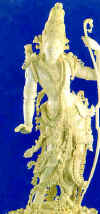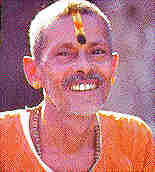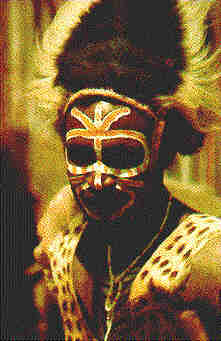
Namaskar or Namaste is the common Hindu mode of greeting. It is also used as a mode of prayer. Seen here is a murti (idol) of the Hindu god Sri Ramchandra commonly known as Ram.

Namaskar or Namaste is the common Hindu mode of greeting. It is also used as a mode of prayer. Seen here is a murti (idol) of the Hindu god Sri Ramchandra commonly known as Ram.
|
|
|
|
_________________________________________________
 This site has been selected by Encyclopedia Britannica "as one of the best on the Internet, when reviewed for quality, accuracy of content, presentation and usability".
This site has been selected by Encyclopedia Britannica "as one of the best on the Internet, when reviewed for quality, accuracy of content, presentation and usability".
______________________________________________
Namaste or Namaskara
Namaste or Namaskara is the traditional Indian form of salutation. It is used while greeting friends and acquaintances as also while paying obeisance to God. As a word it finds its place in the invocation to our different Gods, for instance we have Shri Ganeshaya Namaha Aum Namaha Shivaya, Krishnaya Tubhyam Namaha etc.
 | Namaste could be an amalgam of Namsya (or Namaha) meaning obeisance and 'Te' which means you or to you. Thus Namaste as an
amalgam of Namasyate could be translated as obeisance to you. Namaste involves the joining together of both palms at the level of the breast. If the
person being greeted is a senior or if it is addressed to God, the Namaste is accompanied
with a slight bow. This bow can be termed a slight one for it is only a downward
inclination of the head unlike the Japanese bow where the body is bent at right angles at
the hip. The origin of this graceful and modest form of greeting can only be guessed. Its literal meaning is an indication of it origin. Namaste could be an amalgam of Namsya (or Namaha) meaning obeisance and 'Te' which means you or to you. Thus Namaste as an amalgam of Namasyate could be translated as obeisance to you. The meaning implies a submission of one person to another. Thus, Namaste as a salutation could have originated as an acknowledgement of submission or surrender of one person to another. Hence, it would not be erroneous to infer that Namaste was in fact a declaration of submission. The fact that both hands have to be displayed to the person being greeted could have its origin in the practice that when a person submits to another or when two strangers hail each other they have to prove that they are unarmed and that their intentions are peaceful. This inference may sound incredible, but social anthropologists have established that different types of mutual greetings and salutations have originated in actions of two or more persons (facing each other) which aim at proving that all of them are unarmed and that they come in peace. The origin of the handshake has also been found to be a smilar one. More so, the human smile also is considered to have originated as a sign of submission. Incidentally, this form of greeting has been transmitted from ancient India to the countries of South-east Asia. |
Namaste involves the joining together of both palms at the level of the breast. If the person being greeted is a senior or if it is addressed to God, the Namaste is accompanied with a slight bow. This bow can be termed a slight one for it is only a downward inclination of the head unlike the Japanese bow where the body is bent at right angles at the hip.
The origin of this graceful and modest form of greeting can only be guessed. Its literal meaning is an indication of it origin. Namaste could be an amalgam of Namsya (or Namaha) meaning obeisance and 'Te' which means you or to you. Thus Namaste as an amalgam of Namasyate could be translated as obeisance to you.
The meaning implies a submission of one person to another. Thus, Namaste as a salutation could have originated as an acknowledgement of submission or surrender of one person to another.
Significantly, the Sanskrit word for subjugation is Niyamaha, which is close to Namaha meaning obeisance or submission. Hence, it would not be erroneous to infer that Namaste was in fact a declaration of submission. The fact that both hands have to be displayed to the person being greeted could have its origin in the practice that when a person submits to another or when two strangers hail each other they have to prove that they are unarmed and that their intentions are peaceful.
Origin of the Handshake
This inference may sound incredible, but social anthropologists have established that different types of mutual greetings and salutations have originated in actions of two or more persons (facing each other) which aim at proving that all of them are unarmed and that they come in peace. The origin of the handshake has also been found to be a smilar one.
Originally, in the hazy past of human history, when two strangers faced one another, they 'held' each other's hand in a tight grasp. This assured to both the persons, that the other person was not holding any weapon in his right hand. This later became the congenial etiquette of our handshake. It is difficult to believe today that our friendly handshake, actually originated as a hand-grasp between two suspicious strangers, as a mechanism to reassure both that the other is not an enemy.
Origin of the Left-hand Drive
Even the left-hand drive that we observe for vehicular traffic in most countries did not originate with the coming of motor cars. Even horse riders moved to the left side when facing one another. The reason for this was that they bore their swords on the left side of the hip. And if the oncoming stranger turned out to be an enemy, it was convenient for both the horsemen to draw the sword with their right hand and attack (or defend). This was true even when oncoming strangers were on foot. Hence the left-hand side rule, which later was extended to vehicular traffic.
More so, even the human smile also is considered to have originated as a sign of submission.
Origin of the Human Smile
A smile is nothing but a grin with a feeling of pleasure or happiness and it involves revealing our teeth by parting our lips. But the same action on part of an animal is considered to be a display of anger and fear. Even humans grit their teeth in anger. But this is noticed prominently among animals.
For instance, when two dogs fight over food they snarl and bear their teeth at each other. The human smile, anthropologists say: is a development of the animal grin minus the anger and plus pleasure. When two humans smile at each other they acknowledge that they look upon the other as a friend.
Similarly, Namaste as a greeting could have originated as an act of reassurance or submission between two persons.
_______________________________________________________________________________________________________________________
(You have completed viewing half of this page. If you would like to have a sneak preview into the next page, before you continue viewing the rest of this page, you may roll your mouse over the frame below to see the pictures on the next page which talks about Hindu Beliefs - Satyuga, Swarga, Pralaya, etc.)
|
__________________________________________________________________________________________________________________________ _____
| |||||||||||
The script for the above applet has been written by Chintamani Thakur.
Tilaka and Bindiya
The Tilaka is normally a vermilion mark applied on the forehead. This mark has a religious significance and is a visible sign of a person as belonging to the Hindu religion. The Tilaka is of more than one colour although normally it is vermilion. It also does not have any standard shape and form and is applied differently by members of different Hindu sects and sub-sects.
 | The Tilaka is normally a vermilion mark applied on the forehead. This mark has a religious significance and is a visible sign of a person as belonging to the Hindu religion. The Tilaka is of more than one colour although normally it is vermilion. It also does not have any standard shape and form and is applied differently by members of different Hindu sects and sub-sects. . |
It is applied as a 'U' by worshippers of lord Vishnu and is red, yellow or saffron in colpur. It is made up of red ochre powder (Sindhura) and sandalwood paste (Gandha). Worshippers of lord Shiva apply it as three horizontal lines and it consists of ash (Bhasma). Soot (Abhira) is also used as a pigment for applying a Tilaka.
Thus there is a variety of pigments; red, yellow, saffron, white, grey and black, etc. These pigments are not only applied on the forehead but in some cases they are applied also on the forearms and the abdomen. This is normally so in the case of worshippers of Shiva, a deity whose origin is said to lie in the primitive pre-Arvan or proto-Aryan society.
Literally, Tilaka means a mark. Sindhura which is also used to describe a Tilaka means red and Gandha which is also a term for Tilaka means pleasant odour. Hence, Tilaka normally connotes, a red mark with a pleasant odour. Some scholars have seen the red colour as a symbolism for blood. We are told that in ancient times, in Aryan society, a groom used to apply his blood, on-his bride's forehead as a recognition of wedlock. The existing practice among Indian women of applying a round shaped red Tilaka called Bindiya or Kumkum could be a survival of this.
 | Tilaka literally means a mark. Sindhura which is also used to describe a Tilaka means red and Gandha which is also a term for Tilaka means pleasant odour. Hence, Tilaka normally connotes, a red mark with a pleasant odour. Some scholars have seen the red colour as a symbolism for blood. We are told that in ancient times, in Aryan society, a groom used to apply his blood, on-his bride's forehead as a recognition of wedlock. The existing practice among Indian women of applying a round shaped red Tilaka called Bindiya or Kumkum could be a survival of this. |
Significantly when an Indian woman has the misfortune of becoming a widow she has to stop wearing this mark. In a woman's case a Tilaka is a sign of her being in wedlock Among men, the Tilaka has been traditionally interpreted as a good luck charm. Apart from applying it in the course of normal life, its application had special significance while setting out for a battle, a hunt or before any other event of importance. To demonstrate the person's solemn commitment to succeed in the endeavour he was about to undertake, the Tilaka was made up of the person's own blood. Even today application of one's own blood as a Tilaka is considered to be a display of solemn commitment to the oath or pledge being undertaken.
How this practice of Tilaka came into being is an open question. But anthropological researches show that in most tribal societies in tropical and equatorial regions, there exist customs according to which people paint their naked or semi-naked bodies with different pigments. This may be for decorative and ritualistic reasons. Even today in our civilized way of life, during festivals like Holi or Carnival whose origins are supposed to lie in a primitive tribal past, the smearing of colours is an essential aspect of festivities. Tilaka could be a refined adaptation of this tribal practice.
 | Anthropological researches show that in most tribal societies in tropical and equatorial regions, there exist customs according to which people paint their naked or semi-naked bodies with different pigments. This may be for decorative and ritualistic reasons. Even today in our civilized way of life, during festivals like Holi or Carnival whose origins are supposed to lie in a primitive tribal past, the smearing of colours is an essential aspect of festivities. Tilaka could be a refined adaptation of this tribal practice. |
On the whole it can be said that Tilaka is a survival of the tribal practice of smearing one's body with different colours. This practice was later refined and given a solemn meaning.
.
_________________________________________________
____________________________________
| _ _ _ |
You may view what others have said about this webpage
_____________________________________________________________ We invite you to use our Message Board to start a discussion on any relevant topic ___________________________________________________________
|
_________________________________________________
We invite you to participate in an online chat in our Hindu History Chatroom.
___________________________________________________
_________________________
Other relevant sites
Hindu World
HinduNet
HinduWeb
Hindu Hriday Samrat
Hindu Books
Hindu Literature
HindutvaNet
Hindu Vivek Kendra
Hindu Students Council
RSS
VHP